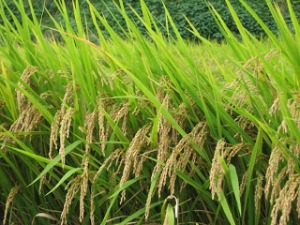From “One Straw Revolution”
The annual seeding and harvesting schedule in the fields starts in early october, before the harvest, white clover and the seeds of fast growing varieties of winter grain are broadcast among the ripening stalks of rice.
The clover and barley or rye sprout and grow an inch or two by the time the rice is harvestable. During the rice harvest, the sprouted seeds are trampled by feet of the harvesters, but recover in no time at all.
When the threshing is finished the rice straw is spread over the fields.
If the rice was spread in the autumn and left uncovered the seeds are often eaten by mice or birds, or they sometimes rot on the ground, and Fukuoka encloses the seeds in clay pellets before sowing. This is done by spreading out the seed on a pan and shaken around with a fine powdered dry clay is spread over top and misted water until it becomes a clay pellet with the intention to make each pellet around one rice grain per. In a day its possible to make enough pellets to seed several acres.
Between mid-november and mid-december he broadcasts the pellets conatining the rice amongst the barley or rye plants but can also be scattered in spring time. Along with the seeds a bit of chicken manure is spread to help decompose the straw.
In May the winter harvest is harvested, after the threshing is finished the straw is scattered all over the fields.
Water is allowed to flood the fields holding back the weeds and clover from growing and allowing the rice to get a head start on growth.
Afterwards rain is enough water for growth until August when fresh water is run through the field once a week without flooding. The Autumn harvest is now at hand.
Fukuoka notes it is possible for 2 or 3 people to farm a quarter acre like this with simple japanese hand tools.
“This way of farming has evolved according to the natural conditions of the Japanese islands, but I feel that natural farming could also be applied in other areas to the raising of other indigenous crops. In other areas where water isnt as readily available, upland rice of other grains such as buckwheat or millet, sorghum might be grown. Instead of white clover, another variety of clover, alfalfa, vetch or lupine might prove a more suitable field cover. Natural farming takes a distinctive form in accordance with the unique conditions of the area in which it is applied.”
“Ultimately, it is not the growing technique which is the most important factor, but rather the state of mind of the farmer”
Masanobu Fukuokas thoughts and life has influenced me a lot in how I view the potential of farming and the potential to improve the soil over time rather than the typical progression of soil depletion of time, but the main thing is leaving things to nature and allowing the weeds to thrive. Letting the soil heal, focusing on growing soil will invariably lead to the growing of crops. Without one we will not have the other…



Pingback: Fukuoka’s Rice Growing Techniques « GreenSky·